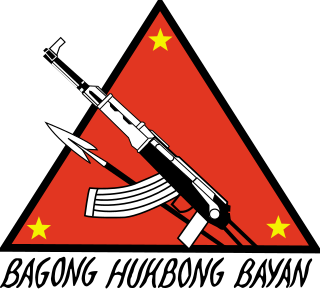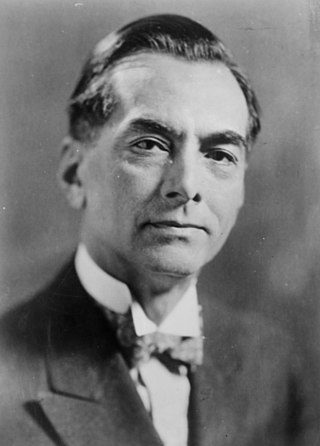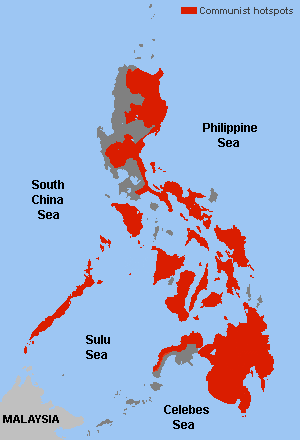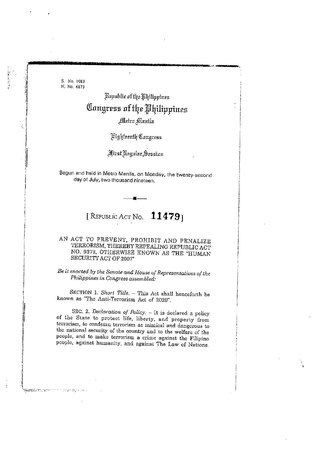
Luis Mangalus Taruc was a Filipino political figure and rebel during the agrarian unrest of the 1930s until the end of the Cold War. He was the leader of the Hukbalahap group between 1942 and 1950. His involvement with the movement came after his initiation to the problems of agrarian Filipinos when he was a student in the early 1930s. During World War II, Taruc led the Hukbalahap in guerrilla operations against the Japanese occupants of the Philippines.

The New People's Army, abbreviated NPA or BHB, is the armed wing of the Communist Party of the Philippines (CPP), based primarily in the Philippine countryside. It acts as the CPP's principal organization, aiming to consolidate political power from what it sees as the present "bourgeois reactionary puppet government" and to aid in the "people's democratic revolution". Founded on March 29, 1969, by the collaboration of Jose Maria Sison and former members of the Hukbalahap led by Bernabe Buscayno, the NPA has since waged a guerrilla war based on the Maoist strategy of protracted people's war. The NPA is one of the key figures in the ongoing Communist rebellion in the Philippines, the longest ongoing conflict in the country.

The Hukbong Bayan Laban sa Hapon, better known by the acronym Hukbalahap, was a communist guerrilla movement formed by the farmers of Central Luzon. They were originally formed to fight the Japanese, but extended their fight into a rebellion against the Philippine government, known as the Hukbalahap Rebellion, in 1946. It was put down through a series of reforms and military victories by Defense Secretary, and later President, Ramon Magsaysay.

The Communist Party of the Philippines is a far-left, Marxist-Leninist-Maoist revolutionary organization and communist party in the Philippines, formed by Jose Maria Sison on 26 December 1968. It is designated as a terrorist group by the United States Department of State together with Sison and its armed wing New People's Army (NPA) in 2002. The European Union renewed its terrorist designation on the organization in 2019, though a 2009 ruling by the EU's second highest court delisted Sison as a "person supporting terrorism" and reversed a decision by member governments to freeze assets. According to the US' Central Intelligence Agency (CIA) World Factbook, the CPP and the NPA aims to destabilize the Philippines' economy and overthrow the national government.

The 1935 Philippine presidential and vice presidential elections were held on September 16, 1935. This was the first election since the enactment of the Tydings–McDuffie Act, a law that paved the way for a transitory government, as well as the first nationwide at-large election ever held in the Philippines.
Crisanto Abaño Evangelista was a Filipino communist politician and labor leader of the first half of the 20th century. He is credited as being one of the founders of the Partido Komunista ng Pilipinas. Evangelista was also an influential head of the Congreso Obrero de Filipinas, at the time the foremost and largest trade federation in the Philippines, having served as secretary for multiple years. He also headed the Union de Impresores de Filipinas as its Secretary-General. Prior to forming the PKP, Evangelista was a member of the Partido Obrero de Filipinas, a Filipino workers' party with increasingly radical leanings. Evangelista was eventually captured by the Japanese during the Second World War and executed.

Pedro Abad Santos y Basco was a Filipino Marxist politician. He founded the Partido Sosyalista ng Pilipinas (PSP) or Philippine Socialist Party in 1929. He ran for several local elections but never won. Luis Taruc of the Hukbalahap Rebellion was under his tutelage and was his right-hand man.

The Partido Komunista ng Pilipinas-1930 (PKP-1930), also known as the Philippine Communist Party, is a communist party in the Philippines that was established on November 7, 1930. It uses the aforementioned appellation in order to distinguish itself from its better known splinter group, the Communist Party of the Philippines.

The ongoing communist rebellion in the Philippines is a conflict between the government of the Philippines and the New People's Army (NPA), which is the armed wing of the Marxist–Leninist–Maoist Communist Party of the Philippines (CPP). The conflict is also associated with the National Democratic Front of the Philippines (NDFP), which serves as the legal wing of the CPP.
Guillermo Capadocia (1909-1951) was a Filipino communist politician and labour leader. He was a prominent leader of the Communist Party in the Philippines (PKP) and different labour movements. During the last one and a half years of his life he was a regional guerrilla commander of the Hukbalahap.
The history of communist armed conflicts in the Philippines is closely related to the history of Communism in the Philippines, with various armed conflict linked to the armed wings of the various communist organizations that have evolved since 1930. The two largest conflicts have been the Hukbalahap Rebellion of 1942–1954, which was initiated by the Partido Komunista ng Pilipinas of 1930 (PKP-1930) and its armed group the Hukbalahap (HMB), and the ongoing rebellion of the New People's Army, which began in 1969 under the auspices of the Communist Party of the Philippines. The latter conflict was still in its infancy in 1972 when Ferdinand Marcos proclaimed Martial law, but expanded significantly as even the moderate opposition against Marcos was radicalized.
Communism in the Philippines emerged in the first half of the 20th century during the American Colonial Era of the Philippines. Communist movements originated in labor unions and peasant groups. The communist movement has had multiple periods of popularity and relevance to the national affairs of the country, most notably during the Second World War and the Martial Law Era of the Philippines. Currently the communist movement is underground and considered an insurgent movement by the Armed Forces of the Philippines.
It was in the late 1960s and early 1970s that the Philippines saw a surge in student activism. This could be chalked up to the onset of the Ferdinand Marcos administration and its declaration of Martial Law, which bore witness to tens of thousands of human rights violations, among many others. There are, however, several factors and events in Philippine history that contributed to the increase in student activism during this period. In fact, economic decline, increase in unemployment rates, the growth of intra-elite conflicts, and internal dissension and disruption all factored into the context of student activism in the Philippines. It was around this time that businesses in Manila tried to find opportunities to withdraw when the city started to be deemed unsafe. Five Communist oriented guerrillas in the countryside had also regained some of the momentum similar to the Huks had before they were contained by Magsaysay in the 1950s. The coming of a revolution was considered a possibility waiting to happen at one point as riots and demonstrations erupted, causing colleges to be closed down. All of these culminated in an effort to storm the Malacañang.
The First Great Rectification Movement refers to a 1965 ideological movement by Filipino communists led by Jose Maria Sison wherein they "criticized, repudiated and rectified the major ideological, political and organizational errors and weaknesses" of the 1930s-era Communist Party of the Philippines. This rectification movement led to the reestablishment of the Communist Party of the Philippines on December 26, 1968 along Marxist–Leninist–Maoist Thought.
Juan Feleo was a Filipino peasant leader and politician. He was one of the founders of one of the Philippines' leading peasant groups, the Kalipunang Pambansa ng Magbubukid sa Pilipinas and a top-ranking member of the Partido Komunista ng Pilipinas. He was also involved in the HUKBALAHAP, and his death sparked the subsequent Huk Rebellion.
Casto Jurado Alejandrino was a Filipino peasant leader and commander of the Hukbalahap. He was the Hukbalahap's vice-commander, second only to its Supremo, Luis Taruc. Alejandrino was one of the few supporters of the Hukbalahap that were also landlords, coming from the Alejandrino family which included former revolutionary general Jose Alejandrino.

At 7:17 pm on September 23, 1972, President Ferdinand Marcos announced on television that he had placed the entirety of the Philippines under martial law. This marked the beginning of a 14-year period of one-man rule that would effectively last until Marcos was exiled from the country on February 25, 1986. Even though the formal document proclaiming martial law – Proclamation No. 1081, which was dated September 21, 1972 – was formally lifted on January 17, 1981, Marcos retained essentially all of his powers as dictator until he was ousted.

The Anti-Terrorism Act of 2020, officially designated as Republic Act No. 11479, is a counter-terrorism law intended to prevent, prohibit, and penalize terrorism in the Philippines. The law was passed by the 18th Congress and signed by President Rodrigo Duterte on July 3, 2020, effectively replacing the Human Security Act of 2007 on July 18, 2020.
Ferdinand Marcos developed a cult of personality as a way of remaining President of the Philippines for 20 years, in a way that political scientists have compared to other authoritarian and totalitarian leaders such as Joseph Stalin and Adolf Hitler, but also to more contemporary dictators such as Suharto in Indonesia, Saddam Hussein in Iraq, and the Kim dynasty of North Korea.










